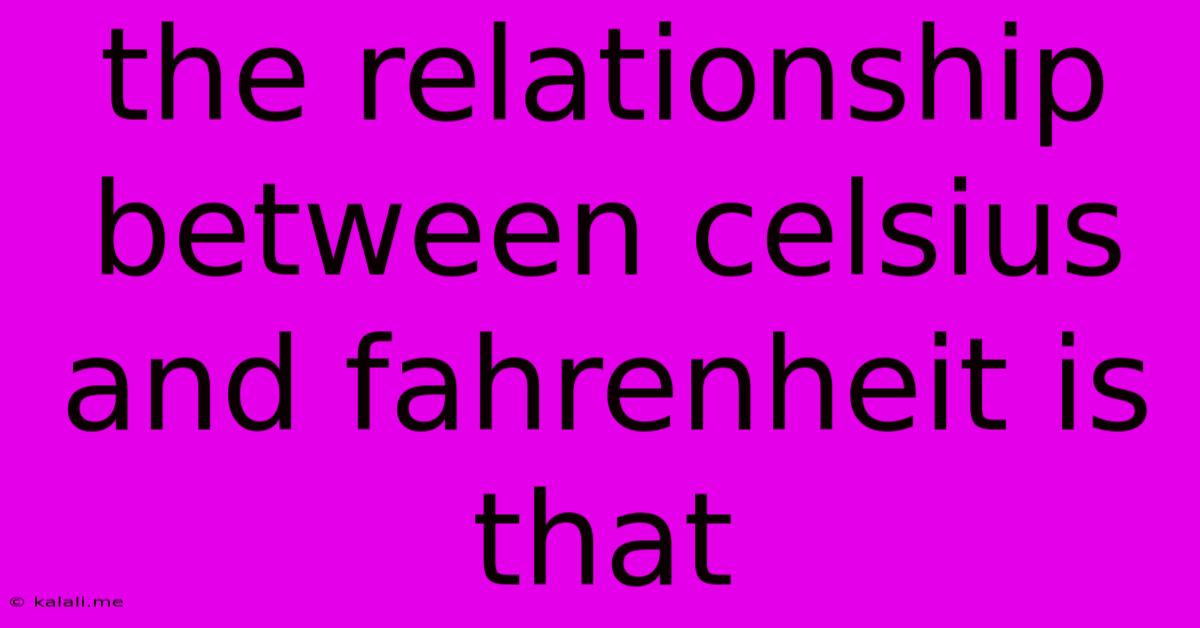The Relationship Between Celsius And Fahrenheit Is That
Kalali
Jun 14, 2025 · 3 min read

Table of Contents
The Relationship Between Celsius and Fahrenheit: A Deep Dive
The relationship between Celsius (°C) and Fahrenheit (°F) might seem confusing at first glance, but understanding their underlying connection reveals a straightforward mathematical formula. This article will explore this relationship, explaining how to convert between the two scales and delving into their historical context. Knowing this conversion is crucial for anyone working with temperature measurements, from scientific research to everyday cooking.
Celsius and Fahrenheit are two different scales used to measure temperature. While both are widely used, they operate on different base points. Understanding the core difference is key to mastering the conversion.
Understanding the Base Points
- Celsius: This scale uses the freezing point of water (0°C) and the boiling point of water (100°C) at standard atmospheric pressure as its defining points.
- Fahrenheit: Fahrenheit's defining points are slightly more complex. It originally used a brine solution (water, ice, and ammonium chloride) as its zero point (0°F), and the human body temperature as 96°F (later revised to 98.6°F).
This difference in base points is the reason for the seemingly arbitrary conversion formula.
The Conversion Formulas
The key to converting between Celsius and Fahrenheit lies in these two formulas:
- Celsius to Fahrenheit: °F = (°C × 9/5) + 32
- Fahrenheit to Celsius: °C = (°F - 32) × 5/9
Let's illustrate with examples:
-
Example 1 (Celsius to Fahrenheit): Convert 20°C to Fahrenheit.
°F = (20 × 9/5) + 32 = 68°F
-
Example 2 (Fahrenheit to Celsius): Convert 68°F to Celsius.
°C = (68 - 32) × 5/9 = 20°C
These examples clearly demonstrate the reciprocal nature of the conversion formulas.
Why Two Scales Exist?
The existence of both Celsius and Fahrenheit stems from historical reasons. Celsius, formerly known as Centigrade, emerged later and is now the preferred scale in most of the world and used in scientific contexts due to its logical and easily understandable scale based on water's properties. Fahrenheit, while less intuitive, remains prevalent in the United States and some other countries due to ingrained usage and historical precedence.
Beyond the Formulas: Understanding the Ratio
While the formulas are essential, grasping the ratio between the scales provides a deeper understanding. For every 5-degree change in Celsius, there is a 9-degree change in Fahrenheit. This ratio is incorporated directly into the conversion formulas.
Practical Applications and Considerations
Understanding the conversion between Celsius and Fahrenheit is vital in various situations:
- Cooking and Baking: Recipes often list temperatures in either scale, requiring conversion for accurate results.
- Science and Engineering: Scientific experiments and engineering projects often require accurate temperature measurements and conversions.
- Weather Forecasting: Weather reports often include temperatures in both scales, requiring understanding for accurate interpretation.
- International Travel: Different countries use different temperature scales, so conversion knowledge is beneficial for understanding local weather conditions.
Mastering the conversion between Celsius and Fahrenheit isn't just about memorizing formulas; it's about understanding the underlying relationship between these two common temperature scales. With a little practice, converting between the two becomes second nature.
Latest Posts
Latest Posts
-
How To Make 35 In Roman Numerals
Jun 15, 2025
-
Difference Between Perfect Competition And Monopolistic Competition
Jun 15, 2025
-
At What Temperature In Fahrenheit Does Water Freeze
Jun 15, 2025
-
What Portion Of The Electromagnetic Spectrum Is Visible
Jun 15, 2025
-
Dot Over I And J Called
Jun 15, 2025
Related Post
Thank you for visiting our website which covers about The Relationship Between Celsius And Fahrenheit Is That . We hope the information provided has been useful to you. Feel free to contact us if you have any questions or need further assistance. See you next time and don't miss to bookmark.